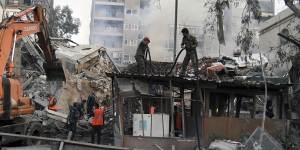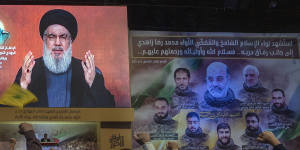Until now,Iran has used proxies to attack Israel,while Israel has avoided airstrikes on Iranian soil. That all changed on April 13 when Iran.

The aftermath of the strike on the Iranian consulate in Damascus.AP
Why did Iran attack Israel?
Iran had vowed revenge since an April 1 airstrike in Syria killed two Iranian generals inside an Iranian consular building. Iran accused Israel of being behind the attack. Israel hasn’t commented on it.
Israel and Iran have been on a collision course throughout Israel’s six-month war against Hamas militants in the Gaza Strip. The war erupted after Hamas and Islamic Jihad,two militant groups backed by Iran,carried out a devastating cross-border attack on October 7 that killed 1200 people in Israel and kidnapped 250 others. An Israeli offensive in Gaza has caused widespread devastation and killed more than 33,000 people,according to local health officials.
Almost immediately after the war erupted,Hezbollah – an Iranian-backed militant group in Lebanon – began attacking Israel’s northern border. The two sides have been involved in daily exchanges of fire,while Iranian-backed groups in Iraq,Syria and Yemen have launched rockets and missiles toward Israel.

Hezbollah leader Sayyed Hassan Nasrallah speaks in a televised address during a ceremony to commemorate the death of the Iranian Revolutionary Guard General Mohammad Reza Zahedi and six officers,who were killed by an Israeli airstrike in Syria.AP
Among those killed by the airstrike on the Iranian consulate in Damascus was General Mohammad Reza Zahedi,a top general in Iran’s Revolutionary Guard. Zahedi was responsible for Iran’s operations in Syria and Lebanon and was reported to have been involved in the “planning and execution” of the October 7 attack on Israel.
This attack marks the first time Iran has launched a direct military assault on Israel,despite decades of enmity dating back to the country’s 1979 Islamic Revolution. Condemnation from the United Nations chief and others was swift,with France saying Iran “is risking a potential military escalation”. Britain called the attack “reckless” and Germany said Iran and its proxies “must stop it immediately”.
How might a war between them be fought?
Iran opened its attack by launching more than 100 bomb-carrying drones toward Israel. Hours later,Iran announced it had also launched much more destructive ballistic missiles and cruise missiles. The Israeli Defence Forces said the “vast majority” of missiles launched from Iran were intercepted outside Israel’s borders. Israel has made missile defence a priority,with a variety of air defence systems available to shoot down incoming missile and drone fire.
The details of Iran’s current capabilities contained in a US Defence Intelligence Agency assessment released with little fanfare on April 11 suggested that any Iranian attack on Israel would likely be a combination of the two.
“Tehran’s missile force is increasingly augmented by Iran’s UAVs[unmanned aerial vehicles] and serves as the regime’s primary conventional deterrent against attacks on its personnel and territory,” the agency said. It added that Iran has a “substantial inventory” of ballistic and cruise missiles capable of striking targets 2000 kilometres away – putting Israel well within range.
Israeli fighters would be expected to strike back,including those in its fleet of stealthy F-35I Adir and non-stealthy F-15I fighters. An F-35 made aviation history when the Israeli Air Force announced in November that it had shot down a cruise missile from the south-east headed toward Israeli airspace.
Israel scrambled navigational signals over the Tel Aviv metropolitan area early this month to prepare for an Iranian attack,a showcase of its capabilities. It did so again on April 13 after Iran began its attack.
Explosions could be heard over Jerusalem as US forces intercepted Iran drones.
A more remote possibility remains:Iran could also direct proxies to deploy militants on the ground from Syria or Lebanon. The one precedent for Iran attacking Israeli territory came in 2018,when Tehran fired rockets from Syria on positions in the Golan Heights.
Another likelihood is cyberwar. More than a decade ago,malware known as Stuxnet compromised operations at an Iranian nuclear enrichment facility in what’s suspected to have been a US and Israeli operation. Iran has also launched attacks of its own,including a hack that sought to cripple computers and water flow for two Israeli districts,according to the Council on Foreign Relations.
How do Israeli and Iranian military capabilities compare?
Israel’s forces are vastly superior to Iran’s when it comes to technology. Iran,however,has massive stockpiles of cheap,but effective,weapons in its arsenal.

Israel’s Iron Dome air defence system launches from central Israel to intercept missiles fired from Iran.AP
Since 2022,Iran has provided more than 1000 Shahed-136 UAVs,as well as Shahed-131 and Mohajer-6 UAVs,to support Russia’s invasion of Ukraine. In May,Iran began assisting Russia in establishing a Shahed-136 UAV production facility in Russia,according to the US Defence Intelligence Agency. So it’s safe to assume that Iran has hundreds – if not thousands – of one-way drones in its inventory to attack Israel.
Israel would counter ballistic missiles with its Arrow interceptors and drone attacks,possibly with David’s Sling air defence systems and perhaps with a system called Drone Guard made by ELTA Systems.
Who are their allies? What roles might they play?
Iran’s most important allies are the Shiite militias in Lebanon,Iraq,Syria and Yemen,which it supports with money,weapons and training. The Lebanese militia Hezbollah would be positioned to play the most significant role. It’s fought repeated battles with Israel and has been regularly firing missiles,mortars and rockets into northern Israel since war broke out in October between Israel and the Iran-backed militant Palestinian group Hamas. Hezbollah’s arsenal contains more than 70,000 rockets and missiles,including long-range and precision-guided missiles,according to Israeli intelligence.
An escalation of its attacks on Israel could test the country’s defences at a time when it was also confronting Iran and Hamas.
Iran’s only state ally in the Middle East is Syria. The government of President Bashar al-Assad would be unlikely to be of assistance given that it’s still struggling to gain control over the entire country following the outbreak of civil war in 2011.
Iran has good relations with Russia,though its war in Ukraine would likely limit its ability to help,and with China,which has bought Iranian oil,though it remains sanctioned by the US and allies.
Israel has the US on its side. Already the US is expediting shipments of munitions to Israel,to help it fight Hamas. Among the US forces in the Middle East region are two Navy destroyers that moved to the eastern Mediterranean in early April,according to a Navy official – the USS Carney and the USS Arleigh Burke,both capable of air defence.

Joe Biden meets with his National Security team at the White House on Iran’s attacks on Israel.AP
Early in the Israel-Hamas war,the Pentagon moved its newest aircraft carrier,the Gerald R. Ford,and its battle group into the eastern Mediterranean. It has since returned home.
The Dwight D. Eisenhower carrier strike group is on its way from operations against the Houthis. Each bristles with F/A-18E/F Super Hornet fighter jets and other advanced aircraft. In addition,2000 Marines were put on heightened alert for potential mobilisation.
How might Arab states react?
An Israel-Iran war would put many of the countries in the region in a difficult position. Four Arab countries made peace deals with Israel in 2020 via the so-called Abraham Accords. Their distrust of Iran was part of what brought them together. But it’s unlikely any Arab state would stand with Israel in a confrontation against a fellow Muslim country,let alone one as powerful as Iran.
Iran and Saudi Arabia last year restored diplomatic relations after a seven-year freeze. with Israel as part of a broader deal in which it hopes to attain US security guarantees,and it would likely try to avoid becoming embroiled in the conflict.
Bloomberg,AP
Get a note directly from our foreigncorrespondentson what’s making headlines around the world..